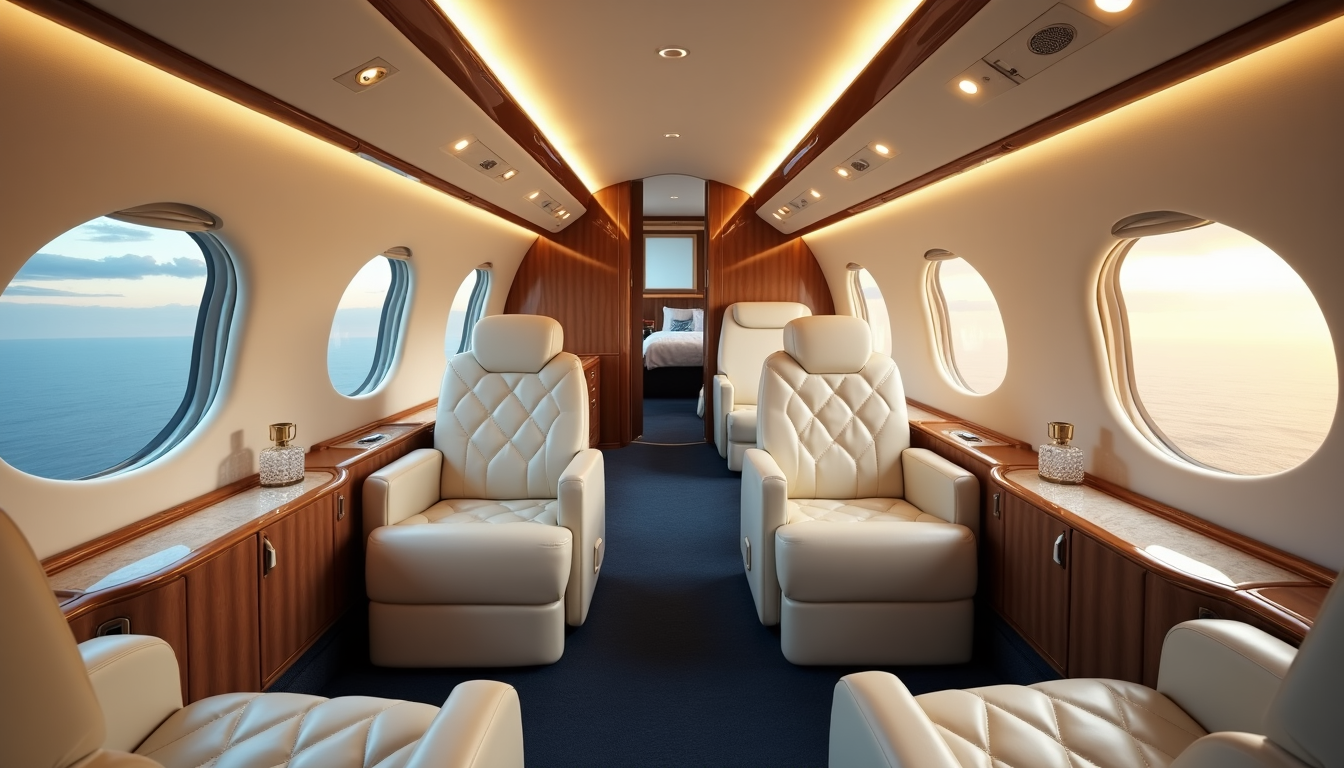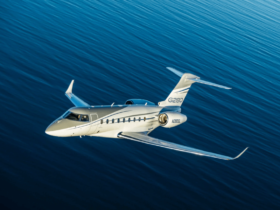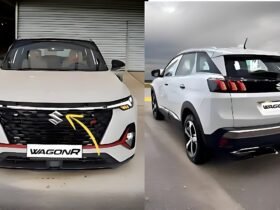
Luxury private jets now showcase unprecedented opulence. The Boeing 747-8 “flying mansion” comes with an astounding $400 million price tag. These aerial palaces rival high-end hotels with their amenities that include full-sized master bedrooms, gold-plated bathroom fixtures, and gourmet kitchens.
Private jet interiors have grown way beyond simple comfort. These aircraft feature extraordinary elements like the Airbus A380’s concert hall, Turkish baths, and even car garages. The ultra-wealthy can customize their jets endlessly, with some owners putting hundreds of millions into personalized modifications.
The remarkable world of elite aviation holds stunning amenities and innovative designs that few people know about. Crystal-adorned bathrooms and revolutionary cabin technologies reshape the way ultra-wealthy travelers experience the skies.
The New Era of Private Jet Interiors
Private jet cabins have turned into personal havens that match the elegance of luxury homes. The way these flying spaces have changed shows a fundamental change in how we see airborne luxury.
Beyond traditional luxury definitions
Modern private jet interiors no longer follow old-school opulence. Designers create spaces that extend their owners’ lifestyles. Today’s cabins showcase flowing shapes and aerodynamic-inspired interiors. They also use sustainable materials like carbon fiber and recyclable fabrics.
Rise of private aviation design
Private jet design has changed dramatically in the last decade. These interiors now feature:
- Fluid architectural elements
- High-performance green materials
- Personal art installations
- Biophilic design elements
- Smart cabin management systems
Designers now prefer lighter, more playful esthetics instead of traditional dark wood veneers and heavy leathers. This change shows a better understanding of how spaces affect passengers’ well-being during flight.
Setting new standards in the sky
Modern private jet interiors set new standards through creative features and smart design. Cabins now include advanced mood lighting that mimics natural light patterns. Smart technology lets passengers control everything in their environment, from temperature to entertainment options.
Wellness has become a priority in cabin design. Jets now have spaces dedicated to relaxation and rejuvenation. Passengers arrive at their destinations feeling refreshed. Better air quality systems and ergonomic seating designed for long-haul comfort show this focus on health.
A steadfast dedication to green practices has also changed design standards. Designers use eco-friendly materials and energy-efficient features while keeping luxury at its peak. This balance between environmental awareness and premium comfort points to the future of private aviation interiors.
Extraordinary Amenities That Defy Gravity
Modern elite aircraft blend engineering excellence with luxury comfort. The latest private jet features expand what you can experience at 40,000 feet.
Gold-plated fixtures and crystal elements
Gold-plated fixtures in private jet bathrooms go beyond pure esthetics. These installations combine visual beauty with exceptional durability and corrosion resistance, which ensures they last under heavy use. Each fixture can showcase intricate designs and personal logos that match the owner’s style while specialized cleaning methods keep them pristine.
Sky suites and floating bedrooms
Airborne comfort has reached new heights with dedicated sleeping spaces. The Bombardier Global 7500 features a master suite complete with a full-size bed and spacious shower that creates a hotel experience in the sky. The Airbus ACJ 220 takes this concept further by adding functional nightstands, premium materials, and elite furnishings that make the most of personal space.
Innovative entertainment systems
Private jets now come with entertainment systems that match high-end home theaters. These advanced setups include:
- Ultra-high-speed Wi-Fi for smooth video calls and streaming
- Interactive gaming and virtual reality at cruising altitude
- High-definition screens with surround sound systems
- Content libraries customized to match passenger priorities
Entertainment goes beyond traditional screens. Custom aircraft displays combine smoothly with cabin management systems. Passengers can control lighting, temperature, and audio-visual elements from their devices. New AI-driven solutions learn passenger priorities to create a more customized flying experience.
Devialet high-fidelity audio systems set new standards for in-flight sound quality. These systems work with noise-canceling technology to deliver crystal-clear audio at any altitude. Modern entertainment options turn travel time into an interactive adventure for both business and leisure.
Revolutionary Design Features
Private jets now feature groundbreaking design elements that blend functionality with sophistication. These new features adapt to passengers’ needs without compromising luxury standards.
Smart glass technology integration
Modern private jets come equipped with electronically dimmable windows that revolutionize the cabin experience. SPD (Suspended Particle Device) technology in these smart windows blocks 99.9% of harmful ultraviolet radiation. A simple touch lets passengers adjust window tint from clear to opaque, which creates their ideal environment for rest, entertainment, or work.
Smart glass technology has expanded to cabin dividers. These trailblazing partitions switch between transparent and opaque states and serve as smart displays for messages and entertainment. PDLC (Polymer Dispersed Liquid Crystal) film treatment on glass panels gives passengers instant privacy control, which proves valuable during long flights.
Transformable cabin spaces
Designers have redefined space optimization in private jet interiors through expandable solutions. The adaptable spaces feature:
- Convertible seats with built-in storage compartments
- Modular seating arrangements for flexible configurations
- Multi-functional furniture that switches between dining and work areas
The Shapeshifter concept shows this versatility perfectly. The design includes furniture that changes functions at the push of a button. A credenza becomes a workstation while the lounge area transforms into a dining space.
Biophilic design elements
Natural elements play a bigger role in private jet interiors by creating harmony between passengers and nature. Designers use environmentally responsible materials like silk bamboo carpets and reclaimed oak. Living walls with lightweight, low-maintenance plants thrive in aircraft environments and add natural beauty to the space.
Digital skylights boost the biophilic experience by creating an immersive connection to the outside world. These features complement the organic shapes and curved lines throughout the cabin. Traditional angular designs give way to fluid forms that reflect natural elements.
These revolutionary design features show how private jet interiors balance technology with comfort. Smart glass, transformable spaces, and natural elements create responsive environments that offer exceptional sophistication to travelers.
Unprecedented Luxury Experiences
Flying aboard elite aircraft today goes beyond traditional travel and rivals the world’s finest resorts. Private jet operators have reimagined in-flight luxury with innovative wellness, dining, and entertainment options.
Sky spas and wellness centers
Private jets now feature complete wellness programs that turn flight time into therapeutic experiences. These airborne sanctuaries provide specialized treatments like hydrating facials, regenerating eye treatments, and therapeutic massages. Jets have dedicated spaces for relaxation and rejuvenation to meet passengers’ growing focus on health-conscious travel.
The wellness programs go beyond simple treatments and include:
- Pre-flight nutritionist consultations
- Jet lag management services
- Customized meditation sessions
- JING Teas single-origin herbal infusions
- Guerlain hydrating skincare amenities
Gourmet kitchens at 40,000 feet
Skilled chefs take culinary excellence to new heights in onboard gourmet kitchens. The chefs prepare fresh meals onboard instead of reheating them. Passengers start with canapés and champagne before enjoying expertly crafted multi-course meals with seasonal ingredients.
The culinary teams understand how taste changes at high altitudes and adjust flavors and preparations. Private jet kitchens serve restaurant-quality meals in the sky. The menus feature sophisticated dishes such as whiskey-cured wild salmon with buckwheat blinis and Chilean seabass with sauce vierge.
Virtual reality entertainment zones
Private jets now feature innovative virtual reality entertainment systems alongside traditional amenities. Passengers can choose from virtual sightseeing tours to interactive gaming through these immersive experiences. The VR technology helps with stress relief and meditation through calming virtual environments.
Advanced features in the entertainment systems boost the flying experience. Passengers can take virtual tours of famous landmarks or join interactive experiences from their seats. The systems provide customized content based on individual priorities, making each flight unique for entertainment options.
Wellness, culinary excellence, and virtual reality combine to create exceptional luxury in private aviation. These innovative amenities redefine air travel possibilities, and passengers arrive at their destinations feeling refreshed and rejuvenated.
Future of Airborne Luxury
Private aviation enters a new era with state-of-the-art technologies that redefine luxury air travel. The global AI in aviation market shows promising growth from USD 152.40 million in 2018 to over USD 2.20 billion by 2025. This radical alteration reflects our changing experience of private flight.
AI-powered personalization
AI technology transforms the private jet experience through hyper-personalization. Advanced AI systems analyze passenger data to create targeted experiences. These intelligent systems provide individual-specific experiences through tailored trip assistants that adapt to passenger priorities, from in-flight entertainment to dining options.
AI-powered chatbots now serve as virtual concierges that handle queries and flight changes 24/7. These sophisticated systems create smooth communication through popular messaging platforms like WhatsApp, Facebook Messenger, and other channels.
Sustainable luxury innovations
Airborne luxury now combines environmental responsibility with elegance. Sustainable Aviation Fuel (SAF) leads this transformation with remarkable benefits:
- Reduces lifecycle greenhouse gas emissions by up to 80% compared to conventional jet fuel
- Produced from renewable resources like plant oils and agricultural residues
- Accessible to more people at airports worldwide
Comfort remains paramount while sustainability stimulates progress. Modern aircraft designs feature lightweight materials and energy-efficient systems. Operators now invest in carbon offsetting programs that support reforestation initiatives and renewable energy projects.
Next-generation comfort technologies
Cabin comfort technologies have taken a major leap forward. Honeywell’s next-generation Cabin Pressure Control and Monitoring System demonstrates this progress by weighing 30% less than its predecessor with improved sensor accuracy. This system maintains optimal cabin pressure and reduces maintenance needs.
AI-driven predictive analytics will optimize air management based on up-to-the-minute data analysis. These systems adjust cabin conditions through variable-speed compressors and energy-recovery systems.
Smart seating technology brings another breakthrough in passenger comfort. Advanced seats come equipped with built-in massage functions, temperature controls, and adjustable armrests. Pressure sensors detect extended periods of passenger inactivity and automatically adjust seat positions to improve circulation.
Health-monitoring features mark a revolutionary advancement. Advanced seats track vital metrics like heart rate, posture, and breathing patterns and share data with cabin crew to manage passenger health proactively. This information enables immediate adjustments that ensure optimal passenger comfort throughout the flight.
Conclusion
Private jet luxury has reached heights beyond our imagination. Gold-plated fixtures, smart glass technology, and AI-powered systems have revolutionized private aviation. These jets now match the luxury standards of the world’s finest hotels and resorts.
The path ahead looks bright as eco-friendly innovations combine with innovative comfort technologies. Private jet manufacturers focus on environmental responsibility and passenger comfort. The jets now feature smart cabin systems and wellness features that show how far the industry has come from its early days.
Technology now improves the human element in luxury travel instead of replacing it. AI-driven customization, sustainable materials, and groundbreaking design features create an exceptional flying experience. These jets cater to individual priorities while addressing environmental concerns.
Private jets are no longer just transportation vehicles – they’ve become sanctuaries in the sky. These aircraft deliver outstanding comfort, technology, and luxury that challenge what’s possible at 40,000 feet.
FAQs
Q1. What are some of the most luxurious features found in private jets? Modern private jets offer extraordinary amenities such as gold-plated bathroom fixtures, full-sized master bedrooms, gourmet kitchens, and even sky spas. Some aircraft feature smart glass technology, transformable cabin spaces, and virtual reality entertainment zones, providing an unparalleled level of luxury and comfort.
Q2. How are private jet interiors evolving to meet new standards of luxury? Private jet interiors are moving beyond traditional opulence, focusing on personalized spaces that reflect owners’ lifestyles. Designers are incorporating sustainable materials, biophilic elements, and advanced technologies like mood lighting and smart cabin management systems. The emphasis is on creating environments that enhance passenger well-being and offer a perfect balance of luxury and functionality.
Q3. What kind of entertainment systems are available on high-end private jets? High-end private jets now feature entertainment systems rivaling home theaters. These include ultra-high-speed Wi-Fi, interactive gaming, virtual reality experiences, high-definition screens with surround sound, and personalized content libraries. Some jets even incorporate AI-driven solutions that learn passenger preferences to create a more tailored flying experience.
Q4. How are private jets addressing sustainability concerns? Private jet manufacturers are embracing sustainability through various innovations. This includes the use of Sustainable Aviation Fuel (SAF), which can reduce lifecycle greenhouse gas emissions by up to 80% compared to conventional jet fuel. Additionally, modern aircraft designs incorporate lightweight materials and energy-efficient systems, while many operators invest in carbon offsetting programs to support environmental initiatives.
Q5. What future technologies can we expect in private aviation? The future of private aviation will likely feature AI-powered personalization, offering tailored experiences based on passenger preferences. Advanced comfort technologies, such as smart seating with built-in health monitoring features, are also on the horizon. We can expect further developments in sustainable luxury, with a continued focus on reducing environmental impact without compromising on the high standards of comfort and elegance.










Leave a Review